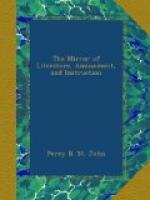THE MIRROR OF LITERATURE, AMUSEMENT, AND INSTRUCTION.
Vol. 14, No. 404.] Saturday, December 12, 1829. [Price 2d.
* * * * *
The Royal Observatory, Greenwich.
[Illustration: The Royal Observatory, Greenwich.]
In the present almanack season, as it is technically called, the above illustration of our pages may not be inappropriate or ill-timed, inasmuch as it represents the spot whence all English astronomers make their calculations.
The Observatory was built by Charles II., in the year 1675—probably, observes a recent writer, “with no better motive than to imitate Louis XIV.,” who had just completed the erection and endowment of an observatory at Paris. The English Observatory was fortunately placed under the direction of the celebrated Flamstead, whose name the hill, or site of the building, still retains. He was appointed astronomer-royal in 1676; but Charles (as in the case of the curious dial at Whitehall, described by us a few weeks since[1]), neglected to complete what he had so well begun: and Flamstead entered upon the duties of his appointment with instruments principally provided at his own expense, and that of a zealous patron of science, James Moore. It should seem that this species of parsimony is hereditary in the English Government, for, upon the authority of the Quarterly Review, we learn that “within the wide range of the British Islands there is only one observatory (Greenwich), and scarcely one supported by the Government. We say scarcely one, because we believe that some of the instruments in the observatory at Greenwich were purchased out of the private funds of the Royal Society of London."[2]
[1] For this very accurate
Description with an Engraving, see
mirror,
No. 400.
[2] For the remainder of the
Extract, &c. see mirror, vol. xii.
p.
151. Only a few days since we saw recorded an
instance of
enthusiasm
in the study of astronomy, which will never be
forgotten.
We allude to Mr. South’s splendid purchase at
Paris;
yet
all the aid he received was some trifling remission
of duty!
The first stone of this Observatory was laid by Flamstead, on the 10th of August, 1675. It stands 160 feet above low-water mark, and principally consists of two separate buildings: the first contains three rooms on the ground-floor—viz. the transit-room, towards the east, the quadrant-room, towards the west, and the assistant’s sitting and calculating-room, in the middle; above which is his bed-room, the latter being furnished with sliding shutters in the roof. In the transit-room is an eight-feet transit-instrument, with an axis of three feet, resting on two piers of stone: this was made by Bird, but has been much




